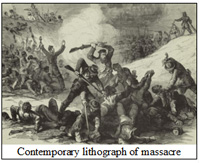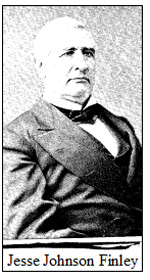
Volume
27, No. 7 – July 2014
Volume 27, No. 7
Editor: Stephen L. Seftenberg
Website:
www.CivilWarRoundTablePalmBeach.org
President’s Message
Long-standing member of the Round Table Dr. Marsha Sonnenblick passed
away on May 28th. Marsha gave terrific programs on Civil War medicine
and the sociological aspects of the War. Her presentations were
well-researched and extremely organized. The highest attendance at a
meeting was given by Marsha, and the topic was "Sex and the Civil War."
Our deepest condolence to her husband, Bernie, and the entire family.
Future Programs
If anyone has a suggestion for a future program or would like to make
a presentation, please call Gerridine LaRovere at 561 967-8911 or e-mail
honeybell7@aol.com. The entire Board would like to thank everyone who
contributed to the Speaker’s Fund. This enabled the Round Table to have
a variety of outside speakers this year.
July 9, 2014 Program
Steve Seftenberg will present a different approach to the Battle of
Shiloh April 6-7. 1862, entitled, "Myths Abound About the Battle of
Shiloh/Pittsburgh Landing." Steve’s position is that the standard
account of Shiloh is filled with myth than fact. No less an authority
than Ulysses S. Grant, the Union commander at the fight, wrote after the
war that Shiloh "has been . . . more persistently misunderstood than any
other engagement . . . during the entire rebellion." One-sided newspaper
reporting and repeated campfire stories that added to, enlarged and
painted a distorted picture of actual events infects modern historical
accounts.
June 11, 2014 Program
Craig Freis has been collecting autographs, historical documents, and
old newspapers for over forty years. Craig brought actual editions of
newspapers such as The New York Times and the New
York Herald dated between 1850 and 1870. Round Table members had
the rare opportunity to read about social, economic, and political
topics, as well as news and casualty lists from the battlefront from
newspapers printed contemporaneously. Unfortunately, your Editor’s
attempts to photograph some of the more interesting pages was a flop.
The attendees wanted Mr. Freis to come back when we can give him a
bigger audience.

First Florida Special Battalion
The First Florida Special Battalion entered
Confederate service at Fernandina in September 1861 with a total of 577
officers and men. The unit, initially commanded by Lieutenant Colonel
Daniel P. Holland, served first as heavy artillery before being
reorganized as infantry on November 13, 1861. Promoted to Lieutenant
Colonel, Charles F. Hopkins became commander in May 1862 and would serve
until the end of the war.
The First Battalion became part of General Finegan's brigade,
engaging in all the operations against the Union forces during their
occupation of Jacksonville. After the evacuation of Amelia Island and
Fernandina, the battalion participated in the actions at St. Johns Bluff
in September-October 1862 and Jacksonville in March 1863. Various
companies also guarded the Apalachicola River from Union attack. In the
summer of 1863, the First Battalion was ordered to reinforce the
defenses at Savannah, Georgia, but the unit would return to Florida in
time to defend the state against the Federal invasion in early 1864. The
First Battalion entered the battle of Olustee with approximately 400
enlisted men and 20 officers. The unit was held in reserve until the
latter part of the battle when, according to a participant, it "went to
the rescue" of General Colquitt’s 64th Georgia, whose
ammunition was nearly exhausted. The men "went in double-quick time" and
"struck right in the center of the battle." Lieutenant Colonel Charles
F. Hopkins commanded the battalion, which suffered official casualties
of three killed and forty-seven wounded. Lieutenant Colonel Hopkins
received slight wounds in his arm and thigh. Lieutenant S. K.
Collins, Company E, was slightly wounded in the face, and Lieutenant
Theophilus Williams, Company F, received a slight chest wound. After the
battle, the unit stayed in Florida until the spring of 1864, when it was
sent to reinforce the Army of Northern Virginia. In June, the First
Battalion, along with four companies from the Second Florida Infantry
Battalion, consolidated and became the new Tenth Florida Infantry
Regiment. The Tenth fought through the Petersburg Campaign of 1864-1865
and surrendered 154 men at Appomattox.
Battle of Fort Pillow
 On April 12, 1864, Confederate General Nathan Bedford Forrest led his
troops against the Union-held Fort Pillow in Lauderdale County,
Tennessee. The fort, with its roughly 600 troops fairly evenly divided
between white and black soldiers, didn’t stand much of a chance against
Forrest’s 1,500 to 2,500 men, surrounded as they were and being fired on
by sharpshooters. To add to that, the Union gunboat U. S. N. New Era
failed to engage the Confederates, and the Federals were unable to
depress their artillery enough to effectively fire on their attackers.
Forrest demanded an unconditional surrender from the fort, which the
Union commander refused, so Forrest’s troops overran the fort, forcing
the Union troops to flee to the river bluff. On April 12, 1864, Confederate General Nathan Bedford Forrest led his
troops against the Union-held Fort Pillow in Lauderdale County,
Tennessee. The fort, with its roughly 600 troops fairly evenly divided
between white and black soldiers, didn’t stand much of a chance against
Forrest’s 1,500 to 2,500 men, surrounded as they were and being fired on
by sharpshooters. To add to that, the Union gunboat U. S. N. New Era
failed to engage the Confederates, and the Federals were unable to
depress their artillery enough to effectively fire on their attackers.
Forrest demanded an unconditional surrender from the fort, which the
Union commander refused, so Forrest’s troops overran the fort, forcing
the Union troops to flee to the river bluff.
What happened next remains a matter of controversy, though the
general consensus is that Confederate troops slaughtered the fleeing
black troops, some as they were trying to surrender. The North was
outraged by the news of what became known as the Fort Pillow Massacre,
and the tragedy renewed Northern support for the war. The Confederates,
who afterwards denied a deliberate, intentional slaughter, left Fort
Pillow that same night without gaining much advantage from their
victory. Military historian David J. Eicher concluded, "Fort Pillow
marked one of the bleakest, saddest events of American military
history."
Jesse Johnson Finley, A Florida Confederate General
 Finley was born near Lebanon, Tennessee, on November 18, 1812, and
served as captain of mounted volunteers in the Seminole War of 1836. He
was admitted to the bar in 1838, was a presidential elector on the Whig
ticket in 1852 and served as a judge of the western circuit of Florida
from 1853 to 1861. Finley was appointed judge of the Confederate States
court for the district of Florida in 1861. He resigned in March 1862 and
volunteered as a private in the 6th Florida Infantry of the Confederate
Army, and was successively promoted to be the Colonel of the regiment.
He took part in the Kentucky Campaign in Major General Edmund Kirby
Smith's column. His first significant combat came at the Battle of
Chickamauga, where his regiment captured a battery of Union artillery,
but was unsupported and forced to withdraw with 165 casualties. Promoted
to brigadier general November 8, 1863, he commanded "Finley’s Brigade,"
of Florida infantry in Major General John C. Breckinridge's division in
the Army of Tennessee. His command was caught up in the Confederate rout
at the Battle of Missionary Ridge, but performed well in protecting the
rearguard of the army. General Braxton Bragg expressed his thanks to
Finley for ". . . his gallant bearing and prompt assistance in every
emergency." Finley’s Brigade saw heavy fighting in the Atlanta Campaign
of 1864. He was badly wounded at Resaca and placed on medical leave
until the army reached Atlanta. At the Battle of Jonesborough, his horse
was killed by artillery shell fragments, which severely wounded him
again, but he refused to be evacuated to Atlanta until all of his
wounded men had been cared for. Finley surrendered with Major General
Howell Cobb in Columbus, Georgia, and was paroled in Quincy, Florida, on
May 23, 1865. Finley was born near Lebanon, Tennessee, on November 18, 1812, and
served as captain of mounted volunteers in the Seminole War of 1836. He
was admitted to the bar in 1838, was a presidential elector on the Whig
ticket in 1852 and served as a judge of the western circuit of Florida
from 1853 to 1861. Finley was appointed judge of the Confederate States
court for the district of Florida in 1861. He resigned in March 1862 and
volunteered as a private in the 6th Florida Infantry of the Confederate
Army, and was successively promoted to be the Colonel of the regiment.
He took part in the Kentucky Campaign in Major General Edmund Kirby
Smith's column. His first significant combat came at the Battle of
Chickamauga, where his regiment captured a battery of Union artillery,
but was unsupported and forced to withdraw with 165 casualties. Promoted
to brigadier general November 8, 1863, he commanded "Finley’s Brigade,"
of Florida infantry in Major General John C. Breckinridge's division in
the Army of Tennessee. His command was caught up in the Confederate rout
at the Battle of Missionary Ridge, but performed well in protecting the
rearguard of the army. General Braxton Bragg expressed his thanks to
Finley for ". . . his gallant bearing and prompt assistance in every
emergency." Finley’s Brigade saw heavy fighting in the Atlanta Campaign
of 1864. He was badly wounded at Resaca and placed on medical leave
until the army reached Atlanta. At the Battle of Jonesborough, his horse
was killed by artillery shell fragments, which severely wounded him
again, but he refused to be evacuated to Atlanta until all of his
wounded men had been cared for. Finley surrendered with Major General
Howell Cobb in Columbus, Georgia, and was paroled in Quincy, Florida, on
May 23, 1865.
After the war he served a part of three consecutive terms in the
House of Representatives but in 1887 was refused a seat in the United
States Senate based on a technicality (his appointment was made before
the vacancy occurred). Finley died November 6, 1904 in Lake City,
Florida and is interred in Evergreen Cemetery, Gainesville, Florida.
Last changed: 07/03/14
Home
About News
Newsletters
Calendar
Memories
Links Join
|

